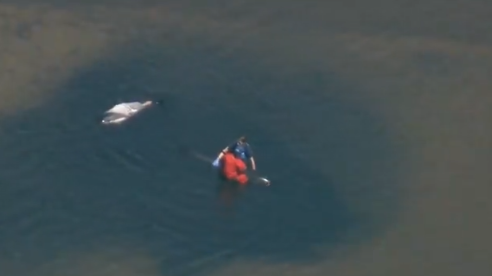Dolphins are akin to our beloved dogs, only far more intelligent. This is why our hearts always are shaken when we see these magnificent creatures in peril.
In a concerted effort to prevent further marine casualties, animal rescue teams were deployed around Cape Cod on Saturday, aiming to prevent dozens of dolphins from becoming stranded in shallow waters. The day prior, an alarming event saw 125 dolphins stranded, prompting immediate action from wildlife conservationists.
Up to 125 Atlantic white-sided dolphins have been stranded on Cape Cod in the US state of Massachusetts. At least 10 have died. The International Fund for Animal Welfare, IFAW, has mobilized some 25 staff and 100 volunteers in an intensive rescue effort. #PlanetMatters pic.twitter.com/fL0TUNL3gy
— CGTN Global Watch (@GlobalWatchCGTN) June 30, 2024
Early on Saturday, the International Fund for Animal Welfare identified a group of 10 Atlantic white-sided dolphins in perilously shallow waters. By daybreak, rescuers had successfully guided these dolphins to deeper, safer waters. However, the challenges continued as another group of 25 dolphins was spotted near the coastline of Eastham. Rescue efforts were intensified as the tide began to recede, with teams working diligently to avert another stranding.
Tragically, the initial stranding event on Friday at The Gut—or Great Island—in Wellfleet claimed the lives of ten dolphins. This site, known for its hook-like geography and dramatic tidal shifts, has been a frequent scene of such unfortunate incidents. The rescue organization remarked that this was the largest mass-stranding event they had confronted in their 26 years of operating in the region.
Over 100 dolphins left stranded on muddy Cape Cod beach before being rescued https://t.co/6zcELuKalV pic.twitter.com/sT7RWvLRaN
— New York Post (@nypost) June 29, 2024
Misty Niemeyer, the stranding coordinator, highlighted the arduous conditions the team faced on Friday. The rescuers dealt with challenging muddy terrain and the need to manage a large spread of dolphins across the area. Despite the intense 12-hour effort under the relentless sun, the team remained determined. Niemeyer emphasized that their perseverance allowed them to provide the stranded dolphins with the best possible chance of survival.
To facilitate the rescue, the team employed three boats equipped with underwater pingers to herd the dolphins. This operation was bolstered by the collective efforts of over 25 staff members from the wildlife organization, alongside 100 dedicated volunteers. Support also poured in from affiliated groups such as Whale and Dolphin Conservation, the Center for Coastal Studies, AmeriCorps of Cape Cod, and the New England Aquarium, all working together to ensure the safety and well-being of these vulnerable marine creatures.
Major Points
- Rescue teams in Cape Cod acted swiftly to prevent dolphin strandings after 125 dolphins were stranded the previous day.
- On Saturday, 10 Atlantic white-sided dolphins were successfully herded from shallow waters into the safety of deeper waters at dawn.
- A second group of 25 dolphins near Eastham required ongoing rescue efforts as the tide receded.
- The initial stranding event on Friday resulted in the deaths of ten dolphins at The Gut, a location notorious for frequent strandings due to its geography and tidal patterns.
- Over 125 staff and volunteers from various conservation organizations collaborated in the rescue efforts, using specialized equipment and boats to guide the dolphins to safety.
RM Tomi – Reprinted with permission of Whatfinger News



